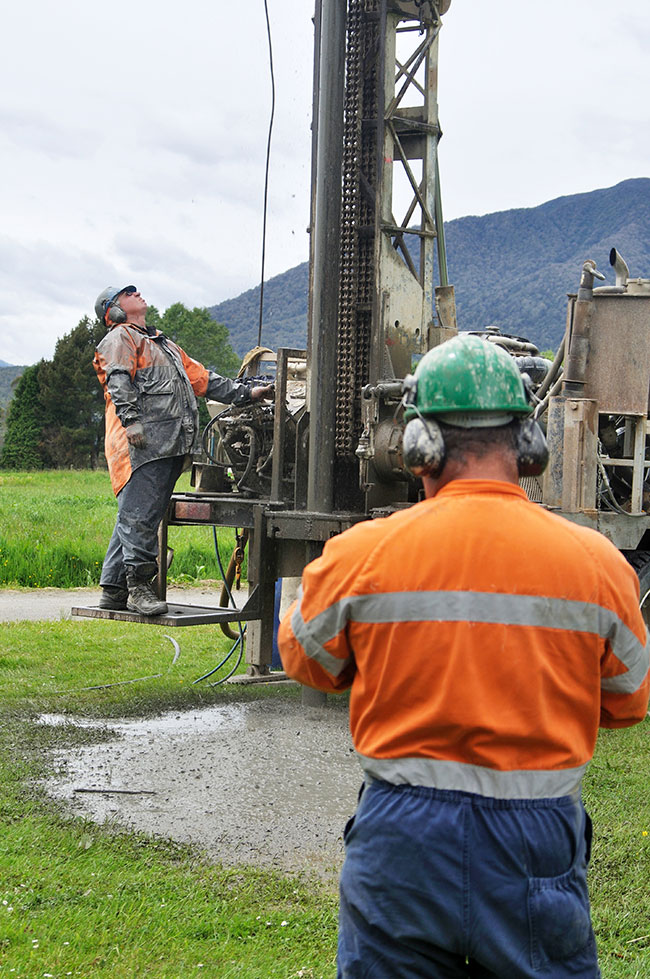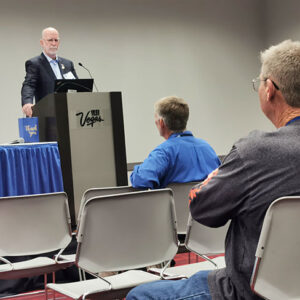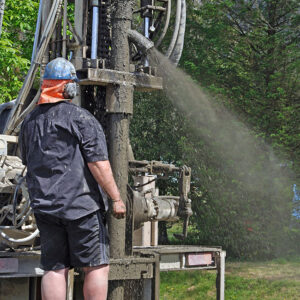
Features
Health & Safety
Safety plan must be in place at drilling sites before any work gets underway
Lack of safety plan is an accident waiting to happen
February 13, 2024 By Mike Jiggens
 Be mindful of spill areas at the drill site where slip-and-fall accidents can easily occur.
Photo credit: Lakeview Images/Adobe Stock
Be mindful of spill areas at the drill site where slip-and-fall accidents can easily occur.
Photo credit: Lakeview Images/Adobe Stock The health and safety of water well drillers must be a company’s foremost concern, well before work begins at a job site or even before arrival. The lack of a preconceived plan is an accident waiting to happen that can result in serious injury or perhaps even death.
Hydrogeologist Marvin Glotfelty and public health and safety administrator Russ Granfors stressed the need to observe health and safety protocols when drilling during an education session they co-presented in December at Groundwater Week in Las Vegas.
Both are principals with Arizona-based groundwater science consulting firm Clear Creek Associates.
Workers must be concerned about such potential hazards as dust storms, overhead power lines, lightning, extreme weather conditions and slip-and-fall risks.
Glotfelty said drilling sites can often be in remote locations that sometime require a slow drive to get there.
“What if there’s an accident or an emergency?” he asked. “You can’t just call 9-1-1 and have an ambulance there in seconds or minutes.”
Such considerations must be built into a safety plan before work begins, he added.
Working in dry zones that are prone to periodic dust storms can lead to such serious illnesses as silicosis if the proper precautions aren’t enforced. Protective masks must be readily available and always worn in such occurrences, Glotfelty said.
“Even if you’re in there for a short bit, it’s very important not to feel like you can hold your breath.”
He said he was aware of a driller who wore a mask when wind-blown dust was an issue, but the worker cut a small hole in it to accommodate his cigarette.
“You can’t cheat the system that way,” Glotfelty stressed. “You have to have proper health and safety equipment.”
Dust storms don’t just come out of the blue, he said. Their arrival is usually predictable, making planning important. He said when a storm is imminent, a job such as running casing or an equally critical activity should be delayed until the storm passes.
Dry areas can also attract potentially dangerous wildlife that can sniff out water and be drawn to a drilling site. Companies must be aware of such dangers to prevent their employees from being bitten or stung.
Ensure sites are well lit
Drilling work is sometimes done after nightfall which requires proper lighting. Although the rig might be adequately lit, there are apt to be darker areas on the job site where tools are stored. If a worker visits an ill-lit area at a job site, he might trip over something unseen and become seriously injured. Glotfelty said tools and other equipment tend to shift around to different sectors throughout the day and might be left in a dangerous location after dark.
Darkness can also contribute to slip-and-fall accidents when they can’t be seen. Glotfelty said attention to detail and the need to clean up spills and other messes are just as important during daylight hours.
“Slip-and-fall hazards are substantial around drill sites, so be mindful of that. We can clean up as we go and minimize that.”
Drill rigs must be outfitted with properly installed rails to prevent slip-and-fall accidents on slippery surfaces. Rails that are in rickety condition won’t be effective, Glotfelty said.
“If someone were to take a fall – even a short distance – they could be seriously hurt.”
Anything more than four feet should be railed, he added.
Messes should be properly hosed down and cleaned up to ensure proper traction is afforded around slippery surfaces, he said.
Hard hats must always be worn, Glotfelty stressed, noting that even the tiniest nut falling from a rig derrick onto an unprotected head could cause substantial injury.
When drilling in residential or commercial districts, sound abatement protocols are necessary. Curtains, however, can turn a job site into a confined workspace. Workers require freedom of movement and the ability to see within their surroundings. Operating a backhoe can limit one’s vision.
Climate considerations
Depending on the location and time of year, drilling can be done in climates that range between severe heat and extreme cold. Heat stress and heat exhaustion can endanger workers’ health, and metal surfaces can get so hot that drillers can be scalded if their unprotected skin encounters such surfaces. Dangers are equally present when surfaces and materials are frozen, and when workers are inadequately dressed for work in sub-zero temperatures.
Wet and dry work environments can also have their share of obstacles, Glotfelty said.
“They all introduce challenges. Wherever you’re at, you need to be thinking about what’s going on there and what’s going to be going on there throughout the course of the project.”
Glotfelty said it’s important to realize that a two-month-long project that spans a couple of seasons needs a health and safety plan that considers temperatures that will either rise or fall significantly.
Before work gets underway, drillers should be familiar with their surroundings and know where to seek safety in the event of a setback.
“Look around to see where you’re going to run if you need to run, because you don’t want to turn around and there’s the mud pit or turn around and run and there’s a steel beam. You want to know where you’re going to go.”
Drillers must know of their rigs’ proximity to power lines, always maintaining a safe distance from the hazard. Some regional regulations insist on a minimum of 10 to 15 feet away from power lines, but Glotfelty suggested such minimum standards might still be too close when winds are strong.
When cables are being tossed around in extreme windy conditions, they might touch power lines if the rig isn’t a safe enough distance away. People’s lives can’t be put at risk when high voltage is so close, he said. Power lines can be de-activated, if necessary, but there’s a cost associated with de-activation and sufficient time must be provided for its scheduling.
One problem can often lead to another, creating a domino effect, Glotfelty said. He cited a situation in which a rig’s hydraulics had overheated to such an extent that hot fluids spilled onto the exhaust manifold, setting the rig on fire.
Beware of lightning
Granfors emphasized that lightning and drill rigs don’t mix. When lightning is present, adopting the “6-30-30” measure is a good rule of thumb. If the time separating a clap of thunder from visible lightning is six seconds or less, “it’s time to get into your truck.” If there are 30 seconds between thunder and lightning, it’s still close enough to be dangerous. Waiting out 30 minutes after the final flash of lightning is a good safety measure.
“Don’t be on a rig when lightning’s close by,” he said.
At sites operating 24 hours a day with crews coming and going, workers must be mindful about where they park their trucks and trailers, Granfors said. They should be parked at least 1½ mast lengths away from a drill rig, he suggested.
“It’s just an extra safety feature so that you don’t have to worry about anything in case a problem comes up.”
Granfors said drill rigs will eventually break down, making it important to notice potential setbacks before they become a safety issue. Cables should be checked regularly. If they require changing, it could mean a day or two of shutdown. If a cable breaks and injures someone, “now you’re down for a week at least because you have to have an investigation into that.”
It’s best to find potential setbacks before they happen, Granfors said, adding it’s virtually impossible to find everything that can go wrong.
“You can’t see every piece of cable on that drill rig, but you need to keep your eyes open in case you find them. You need to tell people so you can get it fixed before something bad happens.”
If time permits, checking over rented equipment brought out to a drill site is a good idea, he suggested. Rental companies generally ensure everything is in proper order, but Granfors recalled an incident when a piece of equipment was low on oil and began smoking. As a worker went to check on it, the equipment blew apart, sending fragments of material into the air. The explosion had the potential to kill or injure someone, but the worker and all others at the site were unscathed.
Granfors said a second check of rental equipment – beyond that of the rental company’s – provides valuable peace of mind.
Print this page

